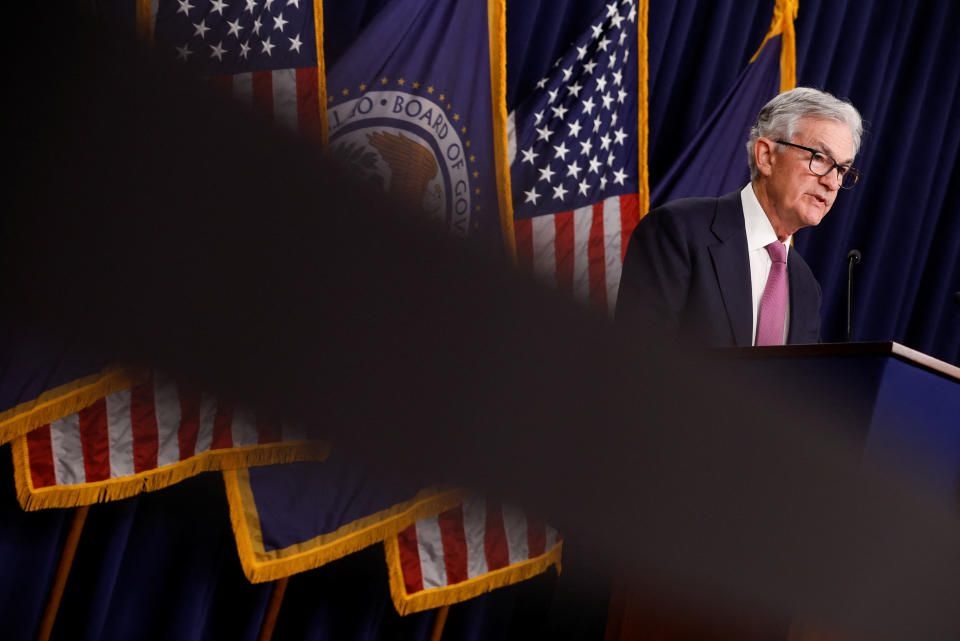"Disinflation."
No fewer than a dozen times on Wednesday did Federal Reserve Chair Jerome Powell say the word "disinflation" during his latest press conference.
And Powell's repeated discussion of this dynamic helped supercharge a stock market rally following the central bank's decision on Wednesday to raise interest rates by another 0.25%.
When the closing bell rang on Wall Street, the tech-heavy Nasdaq was up 2%.
The key quote from Powell came about 20 minutes into his press conference, when, in response to a question from Reuters' Howard Schneider, Powell said, in part: "We can now say, for the first time, that the disinflationary process has started. We can see that."
Unlike inflation (prices going up) or deflation (prices going down) — both of which economists fear in large quantities — disinflation means prices rise at a slower pace. Headline CPI, for example, rose 6.5% over the prior year in December after having jumped as much as 9.1% over the prior year in July. This deceleration in the pace of price increases is disinflation.
This content is not available due to your privacy preferences.
Update your settings here to see it.
To take the importance of Powell's comments a step further, disinflation suggests the Fed may well be able to complete its current interest rate hiking cycle and avoid a severe downturn in the economy.
After all, what the Fed has hoped to achieve is a "soft landing" in which economic growth slows and inflation comes down, but mass layoffs and a recession are avoided.
The Fed's own forecasts suggested a recession would likely follow in 2023 as a result of its 2022 rate hikes, but one month into the year the view from both investors and the Fed chair seems to suggest growing optimism over avoiding this scenario.
"I think most forecasters would say that unemployment will probably rise a bit" from its current level of 3.5%, Powell said Wednesday. "But ... I continue to think that there's a path to getting inflation back down to 2% without a really significant economic decline or a significant increase in unemployment."
"I think many, many forecasters would say it's not the most likely outcome," Powell added. "But I would say there's a chance of it."
U.S. Federal Reserve Chair Jerome Powell addresses reporters after the Fed raised its target interest rate by a quarter of a percentage point, during a news conference at the Federal Reserve Building in Washington, U.S., February 1, 2023. REUTERS/Jonathan Ernst
In Powell's view, the current bout of inflation was borne out of a "collision between very strong demand and hard supply constraints." As both sides of this equation have moderated, the disinflation we're witnessing in goods and the housing market, as two examples, has followed.
And given the unique nature of this business cycle, Powell argued Wednesday similar dynamics will emerge economy-wide.
The market's positive read on Wednesday's comments, however, shouldn't overshadow the significance of the Fed's current program.
With its latest rate hike, the Fed has increased its benchmark rate by 4.5% since March 2022, and the Fed funds rate now stands at its highest level since October 2007.
Look at the stock market endured by investors in 2022. The negative effects of this campaign have been plain to see. And although Wednesday's rate hike marked another superlative in the Fed's current cycle, investors are looking to what the Fed's next moves might be.
Powell was explicit in saying he doesn't believe a decrease in rates will be necessary in 2023. But growing signs that inflation's most deleterious impacts have already been felt were cheered loudly by investors.
Source : [The word that made stocks fall in love with the Fed: Morning Brief](finance.yahoo.com/news/stocks-love-fed-powell-disinflation-morning-brief-110013322.html) undefined - Yahoo | Mail, We
